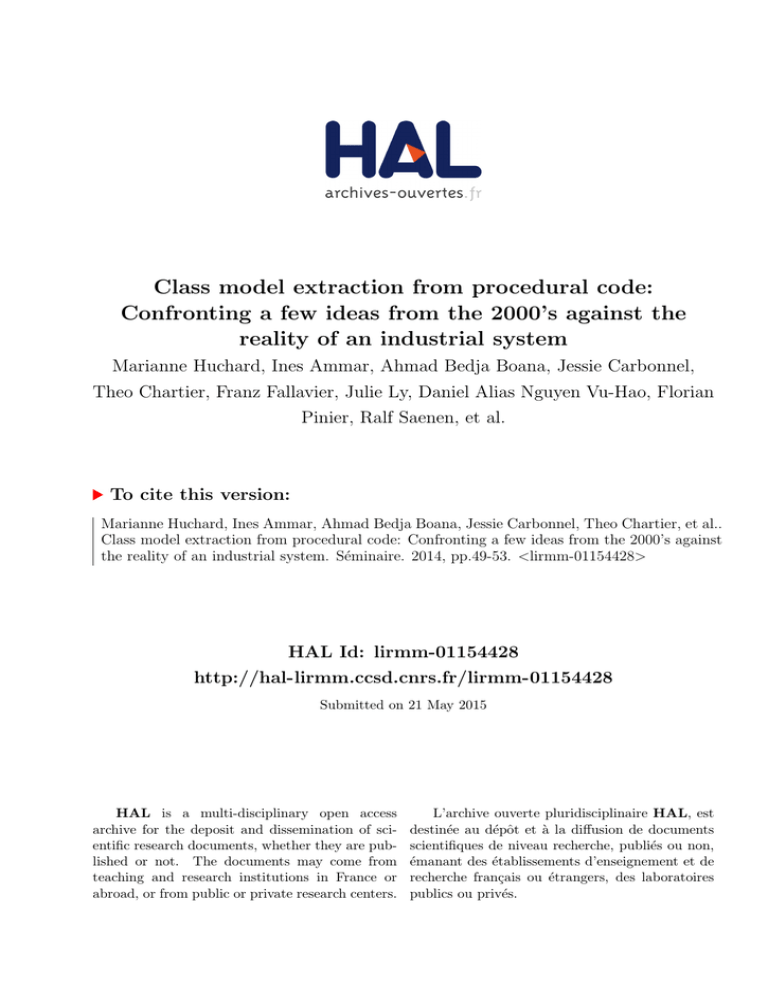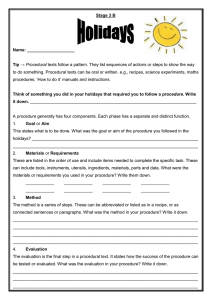Class model extraction from procedural code: Confronting a
advertisement

Class model extraction from procedural code:
Confronting a few ideas from the 2000’s against the
reality of an industrial system
Marianne Huchard, Ines Ammar, Ahmad Bedja Boana, Jessie Carbonnel,
Theo Chartier, Franz Fallavier, Julie Ly, Daniel Alias Nguyen Vu-Hao, Florian
Pinier, Ralf Saenen, et al.
To cite this version:
Marianne Huchard, Ines Ammar, Ahmad Bedja Boana, Jessie Carbonnel, Theo Chartier, et al..
Class model extraction from procedural code: Confronting a few ideas from the 2000’s against
the reality of an industrial system. Séminaire. 2014, pp.49-53. <lirmm-01154428>
HAL Id: lirmm-01154428
http://hal-lirmm.ccsd.cnrs.fr/lirmm-01154428
Submitted on 21 May 2015
HAL is a multi-disciplinary open access
archive for the deposit and dissemination of scientific research documents, whether they are published or not. The documents may come from
teaching and research institutions in France or
abroad, or from public or private research centers.
L’archive ouverte pluridisciplinaire HAL, est
destinée au dépôt et à la diffusion de documents
scientifiques de niveau recherche, publiés ou non,
émanant des établissements d’enseignement et de
recherche français ou étrangers, des laboratoires
publics ou privés.
Class model extraction from procedural code:
Confronting a few ideas from the 2000’s
against the reality of an industrial system
Marianne Huchard? , Ines Ammar, Ahmad Bedja Boana, Jessie Carbonnel,
Theo Chartier, Franz Fallavier, Julie Ly, Vu-Hao Alias Daniel Nguyen, Florian
Pinier, Ralf Saenen, and Sebastien Villon
LIRMM, Université Montpellier 2 et CNRS
{marianne.huchard}@lirmm.fr
http://www.lirmm.fr/~huchard
Abstract. In this extended abstract, we report an ongoing experience
conducted during a Master project on the migration of two industrial
software systems. The project was proposed by a major IT service company (not cited here for confidentiality reasons) which would like to investigate a migration processing chain, in order to renovate legacy software
composed of man-machine interfaces, databases and procedural source
code. The aim of the renovation is to migrate to the object-oriented
paradigm and generate new source code. Due to the limited time that
the Master students had in their curriculum for this project, we restricted
the study to the extraction of a class model. A processing chain was proposed and a few heuristics, taken in the literature, have been tested,
with no really conclusive results. We report here the current status of
the project in order to get feedback and new ideas to build for the future.
Keywords: Software reengineering, software migration, class model extraction, object identification
1
Context and problematics
Software renovation still remains a costly and time-consuming process for IT
service companies, that can be viewed as a waste of resource, compared to the
development of new software. Nevertheless, if timely and effective measures are
not taken to regularly update the design, the source code, the documentation
and all related artifacts, it may arrive the day where the software can no longer
be understood by human, or compiled by the new compilers, or even ran on the
new servers. The challenge is to maintain and migrate with a low cost the legacy
software, before real problems arise. In this extended abstract, we report an
?
The authors would like to thank the IT service companies that brought the renovation project and followed the work in progress and the master students (Luc Debène,
Chaymae Regragui and Cedric Cambon) that made a tutorial for the use of Famix
in the context of this project.
experience, in which we designed a processing chain for renovating a particular
legacy software.
The two studied legacy software systems are part of a larger software suite,
but can be analyzed independently. They are composed of code describing man/machine interface (HTML, VBScript/ASP, Javascript), Visual Basic Code (VB6),
SQL procedures (SQL Server 2000) and two databases. The source code (VB
and SQL) is composed of 909 functions, 30437 LOC for the largest software and
346 functions, 26042 LOC for the smallest software. One database contains 45
tables, while the other contains 103 tables.
Due to the limited time that the Master students had in their curriculum
for this project, we restricted the study to the extraction of a class model. The
students were divided in three groups, but they collaborated throughout the
project. In the next sections, we develop the proposed approach and its current
results (Section 2), then we conclude in Section 3.
2
The renovation approach
The global process The current study is concerned with specific programming
languages, but we aim at proposing a generic processing chain which could be
applied to other procedural and database programming languages (input) and
other object-oriented language (output) of the same company. We decided to
follow a classical processing chain such as that which is presented in Fig. 1,
organized around an intermediate model.
Fig. 1. The generic process
Fig. 2 shows the current instantiated process that we follow. We describe in
next paragraphs the tested tools and methods of each step.
Intermediate model The choice of the intermediate model was partly guided by
simplicity reasons (avoiding complex UML meta-model as proposed in UML2tools
for example) and by the needs of the envisaged heuristics (study data access and
function calls to determine connected sets of data and functions). In order to
represent the source artifacts and the class model, we chose the FAMIX metamodel and its MSE serialization format [5]. For the representation of the output
class model, this was quite natural, because of its language independency and
its ability to describe the static structure of object-oriented software: main used
Fig. 2. The current process
concepts are meta-classse Class, Method, Attribute, Access and Invocation. For
the representation of our input model, we partly used FAMIX in an unusual
manner. Procedural code was easily represented using Function and Invocation.
We met a problem for the representation of database elements. FAMIX being extensible, we thought that it would be the right approach to add meta-classes for
representing data table and columns. Due to the delay, we provisionally abandon
this track, but it remains a future work. Then, we used meta-classes Class and
Attribute to respectively represent tables and columns, even if we don’t consider the solution satisfactory. In this step, we found a difficulty in establishing
a common strategy for the three student groups for the use of FAMIX, because
initially, the groups were using different attributes of the meta-classes for representing the same information (e.g. using signature in Invocation meta-class,
versus candidates).
Source code analysis Man-machine interface source code was partially manually
analyzed, but in a first approach, we decided to abandon the track because of the
little domain knowledge that this code seemed (at first sight) expose. This will be
study into more details in future work. At the beginning, we would like to analyze
VB code using Microsoft Visual studio, but it reveals to be impossible because
of the old version of VB code. This again shows the importance to regularly
update software source code. An evaluation version of VBdepend 1 was tested
and allowed us to retrieve functions, invocations and parameters. As we were
interested in finding the VB functions and the SQL functions that manipulated
the database they called, some specific code has been developed because in the
source code, this is done via a same function that takes as parameters the called
SQL function and its parameters. SQL code has been analyzed with GSP 2 to
extract which SQL procedure has which kind of access to which tables (and
which columns of the tables). We met a few problems in using the two tools, but
more than 99% of the VB functions and more than 91% of the SQL procedures
were correctly analyzed. MSE entities coming from SQL analysis and from VB
analysis are merged to give a unique MSE file for the remainder of the project.
Class model heuristics extraction Each student group had three or four papers
about "object identification" (the term used in 2000’s for talking about class
1
2
http://www.vbdepend.com
http://www.sqlparser.com
model extraction) and they had to choose one for implementation [9, 2–4, 7, 1,
6, 8, 10]. The three methods of [4, 6, 9] have been tried. The approach of [4] is
an ad hoc method based on a hierarchical clustering technique that we had to
entirely implement. The clusters are composed of columns "similarly accessed"
by functions. In [6], they compare several meta-heuristics and we chose among
them the simulated annealing method. The framework AIMA 3 has been used
for the tests. It requires to implement a few Java interfaces by accessing the
MSE files and computing a neighbor solution as well as cohesion and coupling
metrics (on which an objective function is based) on the current solution (a
set of candidate classes composed of data and functions). The approach of [9]
uses Formal Concept Analysis to form concepts composed of functions and their
accessed columns. After concept lattice building, an ad hoc algorithm merges
some concepts and assigns the functions to the classes.
VerveineJ 4 is used in all implementations for finding the entities that are
taken as input of heuristics and MSE files are generated that contain the output
class models.
Current results The hierarchical clustering based implementation allows us to
find different size solutions, depending the chosen level for stopping the clustering. It produces classes which mainly correspond to connected groups of tables
of the initial databases, thus with an explainable logics. Its current issue concerns the methods assignment (only functions that access to a single class are
assigned to that class), thus a complementary approach has to be proposed. The
metrics to be used in simulated annealing approach and their respective weights
were not sufficiently described, and for the moment we are not able to obtain
the same results as those obtained by the author on the example given in the
paper. The FCA approach produces many classes (compared to the database table number). Some obtained classes have a coherence for people of the company,
but some seem to be incidental groups of attributes and methods, technically
explained by accesses and invocations, but with no clear meaning. Besides, even
if the concept lattice guarantees maximal factorization with no redundancies,
the applied post-treatments generate a huge attribute and method duplication.
3
Conclusion
In this extended abstract, we reported an ongoing work that aims at extracting
a class model from procedural code, relying on work mostly done in the 2000s.
Some difficulties were met to apply the methods: some are dedicated to specific contexts (as COBOL code, or C code) and they are not so generic; some
parameters of the methods are not very precisely described, leaving space for interpretation. As we also think that structural aspects, including data access and
function invocation are not sufficient to determine meaningful classes, we plan
to investigate software identifier analysis. Besides, we expect that man-machine
3
4
http://code.google.com/p/aima-java/
http://www.moosetechnology.org/tools/verveinej
interface code or execution trace could be an help to extract connected functionalities. Last, as these techniques have to be understood as a technical assistance
for expert engineers, we would like to study how the user should intervene in the
process.
References
1. Bhatti, M.U., Ducasse, S., Huchard, M.: Reconsidering classes in procedural object-oriented code. In: International Conference on Reverse Engineering (WCRE) (2008), http://rmod.lille.inria.fr/archives/papers/
Bhat08b-WCRE2008-ObjectIdentification.pdf
2. Canfora, G., Cimitile, A., Lucia, A.D., Lucca, G.A.D.: A case study of applying
an eclectic approach to identify objects in code. In: IWPC. pp. 136–143. IEEE
Computer Society (1999)
3. Cimitile, A., Lucia, A.D., Lucca, G.A.D., Fasolino, A.R.: Identifying objects in
legacy systems using design metrics. Journal of Systems and Software 44(3), 199–
211 (1999)
4. van Deursen, A., Kuipers, T.: Identifying objects using cluster and concept analysis. In: Boehm, B.W., Garlan, D., Kramer, J. (eds.) ICSE. pp. 246–255. ACM
(1999)
5. Ducasse, S., Anquetil, N., Bhatti, M.U., Hora, A.C., Laval, J., Girba, T.:
Mse and famix 3.0 : an interexchange format and source code model family.
Tech. Rep. Cutter-Deliverable 22, ANR 2010 BLAN 0219 02, RMod INRIA
Lille-Nord Europe (November 2011), http://rmod.lille.inria.fr/archives/
reports/Duca11c-Cutter-deliverable22-MSE-FAMIX30.pdf
6. Glavas, G., Fertalj, K.: Solving the class responsibility assignment problem using
metaheuristic approach. CIT 19(4), 275–283 (2011)
7. Lucca, G.A.D., Fasolino, A.R., Guerra, P., Petruzzelli, S.: Migrating legacy systems
towards object-oriented platforms. In: ICSM. pp. 122–129. IEEE Computer Society
(1997)
8. Maletic, J.I., Marcus, A.: Supporting program comprehension using semantic and
structural information. In: Müller, H.A., Harrold, M.J., Schäfer, W. (eds.) ICSE.
pp. 103–112. IEEE Computer Society (2001)
9. Sahraoui, H.A., Lounis, H., Melo, W.L., Mili, H.: A concept formation based approach to object identification in procedural code. Autom. Softw. Eng. 6(4), 387–
410 (1999)
10. Zou, Y., Kontogiannis, K.: Incremental transformation of procedural systems to
object oriented platforms. In: COMPSAC. pp. 290–295. IEEE Computer Society
(2003)


